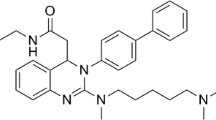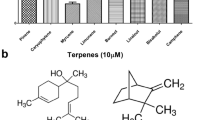Abstract
We have recently identified a class of dihydropyridine (DHP) analogues with 30-fold selectivity for T-type over L-type calcium channels that could be attributed to a modification of a key ester moiety. Based on these results, we examined a second series of compounds with similar attributes to determine if they had enhanced affinity for T-type channels. Whole-cell patch clamp experiments in transfected tsA-201 cells were used to screen these DHP derivatives for high affinity and selectivity for Cav3.2 over Cav1.2 L-type channels. The effects of the two lead compounds, termed N10 and N12, on Cav3.2 channel activity and gating were characterized in detail. When delivered intrathecally or intraperitoneally, these compounds mediated analgesia in a mouse model of acute inflammatory pain. The best compound from the initial screening, N12, was also able to reverse mechanical hyperalgesia produced by nerve injury. The compounds were ineffective in Cav3.2 null mice. Altogether, our data reveal a novel class of T-type channel blocking DHPs for potential pain therapies.









Similar content being viewed by others
References
Barton ME, Eberle EL, Shannon HE (2005) The antihyperalgesic effects of the T-type calcium channel blockers ethosuximide, trimethadione, and mibefradil. Eur J Pharmacol 521(1–3):79–85. doi:10.1016/j.ejphar.2005.08.017
Berjukow S, Marksteiner R, Gapp F, Sinnegger MJ, Hering S (2000) Molecular mechanism of calcium channel block by isradipine. Role of a drug-induced inactivated channel conformation. J Biol Chem 275(29):22114–22120. doi:10.1074/jbc.M908836199
Bladen C, Gunduz MG, Simsek R, Safak C, Zamponi GW (2013) Synthesis and evaluation of 1,4-dihydropyridine derivatives with calcium channel blocking activity. Pflugers Arch - Eur J Physiol. doi:10.1007/s00424-013-1376-z
Bourinet E, Alloui A, Monteil A, Barrere C, Couette B, Poirot O, Pages A, McRory J, Snutch TP, Eschalier A, Nargeot J (2005) Silencing of the Cav3.2 T-type calcium channel gene in sensory neurons demonstrates its major role in nociception. EMBO J 24(2):315–324. doi:10.1038/sj.emboj.7600515
Bourinet E, Altier C, Hildebrand ME, Trang T, Salter MW, Zamponi GW (2014) Calcium-permeable ion channels in pain signaling. Physiol Rev 94(1):81–140. doi:10.1152/physrev.00023.2013
Chen XL, Bayliss DA, Fern RJ, Barrett PQ (1999) A role for T-type Ca2+ channels in the synergistic control of aldosterone production by ANG II and K+. Am J Physiol 276(5 Pt 2):F674–F683
Coste B, Crest M, Delmas P (2007) Pharmacological dissection and distribution of NaN/Nav1.9, T-type Ca2+ currents, and mechanically activated cation currents in different populations of DRG neurons. J Gen Physiol 129(1):57–77. doi:10.1085/jgp.200609665
Dogrul A, Gardell LR, Ossipov MH, Tulunay FC, Lai J, Porreca F (2003) Reversal of experimental neuropathic pain by T-type calcium channel blockers. Pain 105(1–2):159–168
Dray A (2008) Neuropathic pain: emerging treatments. Br J Anaesth 101(1):48–58. doi:10.1093/bja/aen107
Edraki N, Mehdipour AR, Khoshneviszadeh M, Miri R (2009) Dihydropyridines: evaluation of their current and future pharmacological applications. Drug Discov Today 14(21–22):1058–1066. doi:10.1016/j.drudis.2009.08.004
Feng ZP, Doering CJ, Winkfein RJ, Beedle AM, Spafford JD, Zamponi GW (2003) Determinants of inhibition of transiently expressed voltage-gated calcium channels by omega-conotoxins GVIA and MVIIA. J Biol Chem 278(22):20171–20178. doi:10.1074/jbc.M300581200
Furukawa T, Miura R, Honda M, Kamiya N, Mori Y, Takeshita S, Isshiki T, Nukada T (2004) Identification of R(-)-isomer of efonidipine as a selective blocker of T-type Ca2+ channels. Br J Pharmacol 143(8):1050–1057. doi:10.1038/sj.bjp.0705944
Gadotti VM, You H, Petrov RR, Berger ND, Diaz P, Zamponi GW (2013) Analgesic effect of a mixed T-type channel inhibitor/CB2 receptor agonist. Mol Pain 9:32. doi:10.1186/1744-8069-9-32
Gadotti VM, Zamponi GW (2011) Cellular prion protein protects from inflammatory and neuropathic pain. Mol Pain 7:59. doi:10.1186/1744-8069-7-59
Ghelardini C, Desaphy JF, Muraglia M, Corbo F, Matucci R, Dipalma A, Bertucci C, Pistolozzi M, Nesi M, Norcini M, Franchini C, Camerino DC (2010) Effects of a new potent analog of tocainide on hNav1.7 sodium channels and in vivo neuropathic pain models. Neuroscience 169(2):863–873. doi:10.1016/j.neuroscience.2010.05.019
Goldmann S, Stoltefuss J, Born L (1992) Determination of the absolute configuration of the active amlodipine enantiomer as (-)-S: a correction. J Med Chem 35(18):3341–3344
Heron SE, Khosravani H, Varela D, Bladen C, Williams TC, Newman MR, Scheffer IE, Berkovic SF, Mulley JC, Zamponi GW (2007) Extended spectrum of idiopathic generalized epilepsies associated with CACNA1H functional variants. Ann Neurol 62(6):560–568. doi:10.1002/ana.21169
Hildebrand ME, Smith PL, Bladen C, Eduljee C, Xie JY, Chen L, Fee-Maki M, Doering CJ, Mezeyova J, Zhu Y, Belardetti F, Pajouhesh H, Parker D, Arneric SP, Parmar M, Porreca F, Tringham E, Zamponi GW, Snutch TP (2011) A novel slow-inactivation-specific ion channel modulator attenuates neuropathic pain. Pain 152(4):833–843. doi:10.1016/j.pain.2010.12.035
Hockerman GH, Peterson BZ, Sharp E, Tanada TN, Scheuer T, Catterall WA (1997) Construction of a high-affinity receptor site for dihydropyridine agonists and antagonists by single amino acid substitutions in a non-L-type Ca2+ channel. Proc Natl Acad Sci U S A 94(26):14906–14911
Houston JB (1994) Utility of in vitro drug metabolism data in predicting in vivo metabolic clearance. Biochem Pharmacol 47(9):1469–1479
Hylden JL, Wilcox GL (1980) Intrathecal morphine in mice: a new technique. Eur J Pharmacol 67(2–3):313–316
Jagodic MM, Pathirathna S, Joksovic PM, Lee W, Nelson MT, Naik AK, Su P, Jevtovic-Todorovic V, Todorovic SM (2008) Upregulation of the T-type calcium current in small rat sensory neurons after chronic constrictive injury of the sciatic nerve. J Neurophysiol 99(6):3151–3156. doi:10.1152/jn.01031.2007
Jevtovic-Todorovic V, Todorovic SM (2006) The role of peripheral T-type calcium channels in pain transmission. Cell Calcium 40(2):197–203. doi:10.1016/j.ceca.2006.04.024
Kaster MP, Gadotti VM, Calixto JB, Santos AR, Rodrigues AL (2012) Depressive-like behavior induced by tumor necrosis factor-alpha in mice. Neuropharmacology 62(1):419–426. doi:10.1016/j.neuropharm.2011.08.018
Khosravani H (2003) Gating Effects of Mutations in the Cav3.2 T-type Calcium Channel Associated with Childhood Absence Epilepsy. J Biol Chem 279(11):9681–9684. doi:10.1074/jbc.C400006200
Khosravani H, Bladen C, Parker DB, Snutch TP, McRory JE, Zamponi GW (2005) Effects of Cav3.2 channel mutations linked to idiopathic generalized epilepsy. Ann Neurol 57(5):745–749. doi:10.1002/ana.20458
Khosravani H, Zamponi GW (2006) Voltage-gated calcium channels and idiopathic generalized epilepsies. Physiol Rev 86(3):941–966. doi:10.1152/physrev.00002.2006
Koch MA, Wittenberg LO, Basu S, Jeyaraj DA, Gourzoulidou E, Reinecke K, Odermatt A, Waldmann H (2004) Compound library development guided by protein structure similarity clustering and natural product structure. Proc Natl Acad Sci U S A 101(48):16721–16726. doi:10.1073/pnas.0404719101
Kumar PP, Stotz SC, Paramashivappa R, Beedle AM, Zamponi GW, Rao AS (2002) Synthesis and evaluation of a new class of nifedipine analogs with T-type calcium channel blocking activity. Mol Pharmacol 61(3):649–658
Malmberg AB, Basbaum AI (1998) Partial sciatic nerve injury in the mouse as a model of neuropathic pain: behavioral and neuroanatomical correlates. Pain 76(1–2):215–222
Marger F, Gelot A, Alloui A, Matricon J, Ferrer JF, Barrere C, Pizzoccaro A, Muller E, Nargeot J, Snutch TP, Eschalier A, Bourinet E, Ardid D (2011) T-type calcium channels contribute to colonic hypersensitivity in a rat model of irritable bowel syndrome. Proc Natl Acad Sci U S A 108(27):11268–11273. doi:10.1073/pnas.1100869108
Miri R, Javidnia K, Sarkarzadeh H, Hemmateenejad B (2006) Synthesis, study of 3D structures, and pharmacological activities of lipophilic nitroimidazolyl-1,4-dihydropyridines as calcium channel antagonist. Bioorg Med Chem 14(14):4842–4849. doi:10.1016/j.bmc.2006.03.016
Nelson MT, Joksovic PM, Perez-Reyes E, Todorovic SM (2005) The endogenous redox agent L-cysteine induces T-type Ca2+ channel-dependent sensitization of a novel subpopulation of rat peripheral nociceptors. J Neurosci: Off J Soc Neurosci 25(38):8766–8775. doi:10.1523/JNEUROSCI.2527-05.2005
Obradovic A, Hwang SM, Scarpa J, Hong SJ, Todorovic SM, Jevtovic-Todorovic V (2014) CaV3.2 T-type calcium channels in peripheral sensory neurons are important for mibefradil-induced reversal of hyperalgesia and allodynia in rats with painful diabetic neuropathy. PLoS One 9(4):e91467
Peterson BZ, Johnson BD, Hockerman GH, Acheson M, Scheuer T, Catterall WA (1997) Analysis of the dihydropyridine receptor site of L-type calcium channels by alanine-scanning mutagenesis. J Biol Chem 272(30):18752–18758
Peterson BZ, Tanada TN, Catterall WA (1996) Molecular determinants of high affinity dihydropyridine binding in L-type calcium channels. J Biol Chem 271(10):5293–5296
Powell KL, Cain SM, Ng C, Sirdesai S, David LS, Kyi M, Garcia E, Tyson JR, Reid CA, Bahlo M, Foote SJ, Snutch TP, O'Brien TJ (2009) A Cav3.2 T-type calcium channel point mutation has splice-variant-specific effects on function and segregates with seizure expression in a polygenic rat model of absence epilepsy. J Neuroscience 29(2):371–380. doi:10.1523/JNEUROSCI.5295-08.2009
Şafak C, Gündüz MG, İlhan S, Şimşek R, İşli F, Yıldırım Ş, Fincan GS, Sarıoğlu Y, Linden A (2012) Synthesis and Myorelaxant Activity of Fused 1,4-Dihydropyridines on Isolated Rabbit Gastric Fundus. Drug Dev Res 73(6):332–342. doi:10.1002/ddr.21024
Simms Brett A, Zamponi Gerald W (2014) Neuronal voltage-gated calcium channels: structure, function, and dysfunction. Neuron 82(1):24–45. doi:10.1016/j.neuron.2014.03.016
Snutch TP, David LS (2006) T-type calcium channels: an emerging therapeutic target for the treatment of pain. Drug Dev Res 67(4):404–415. doi:10.1002/ddr.20103
Tikhonov DB, Zhorov BS (2009) Structural model for dihydropyridine binding to L-type calcium channels. J Biol Chem 284(28):19006–19017. doi:10.1074/jbc.M109.011296
Todorovic S, Jevtovic-Todorovic V (2014) Targeting of CaV3.2 T-type calcium channels in peripheral sensory neurons for the treatment of painful diabetic neuropathy. Pflugers Arch - Eur J Physiol 466(4):701–706. doi:10.1007/s00424-014-1452-z
Todorovic SM, Jevtovic-Todorovic V (2011) T-type voltage-gated calcium channels as targets for the development of novel pain therapies. Br J Pharmacol 163(3):484–495. doi:10.1111/j.1476-5381.2011.01256.x
Triggle DJ (2003) Drug targets in the voltage-gated calcium channel family: why some are and some are not. Assay Drug Deve Technol 1(5):719–733. doi:10.1089/154065803770381075
Waxman SG, Zamponi GW (2014) Regulating excitability of peripheral afferents: emerging ion channel targets. Nat Neurosci 17(2):153–163. doi:10.1038/nn.3602
Yamamoto E, Kataoka K, Dong YF, Nakamura T, Fukuda M, Nako H, Ogawa H, Kim-Mitsuyama S (2010) Benidipine, a dihydropyridine L-type/T-type calcium channel blocker, affords additive benefits for prevention of cardiorenal injury in hypertensive rats. J Hypertens 28(6):1321–1329. doi:10.1097/HJH.0b013e3283388045
You H, Altier C, Zamponi GW (2010) CCR2 receptor ligands inhibit Cav3.2 T-type calcium channels. Mol Pharmacol 77(2):211–217. doi:10.1124/mol.109.059022
You H, Gadotti VM, Petrov RR, Zamponi GW, Diaz P (2011) Functional characterization and analgesic effects of mixed cannabinoid receptor/T-type channel ligands. Mol Pain 7:89. doi:10.1186/1744-8069-7-89
Zamponi GW, Lewis RJ, Todorovic SM, Arneric SP, Snutch TP (2009) Role of voltage-gated calcium channels in ascending pain pathways. Brain Res Rev 60(1):84–89. doi:10.1016/j.brainresrev.2008.12.021
Zamponi GW, Lory P, Perez-Reyes E (2010) Role of voltage-gated calcium channels in epilepsy. Pflugers Arch - Eur J Physiol 460(2):395–403. doi:10.1007/s00424-009-0772-x
Zamponi GW, Stotz SC, Staples RJ, Andro TM, Nelson JK, Hulubei V, Blumenfeld A, Natale NR (2003) Unique structure-activity relationship for 4-isoxazolyl-1,4-dihydropyridines. J Med Chem 46(1):87–96. doi:10.1021/jm020354w
Acknowledgments
This work was supported by operating grants to GWZ from the Canadian Institutes of Health Research. GWZ is a Canada Research Chair and an Alberta Innovates–Health Solutions (AI-HS) Scientist. CB holds a T. Chen Fong studentship and an AI-HS studentship award. VG holds a MITACS Elevate fellowship. NDB holds an AI-HS summer studentship award.
Author information
Authors and Affiliations
Corresponding author
Rights and permissions
About this article
Cite this article
Bladen, C., Gadotti, V.M., Gündüz, M.G. et al. 1,4-Dihydropyridine derivatives with T-type calcium channel blocking activity attenuate inflammatory and neuropathic pain. Pflugers Arch - Eur J Physiol 467, 1237–1247 (2015). https://doi.org/10.1007/s00424-014-1566-3
Received:
Revised:
Accepted:
Published:
Issue Date:
DOI: https://doi.org/10.1007/s00424-014-1566-3




